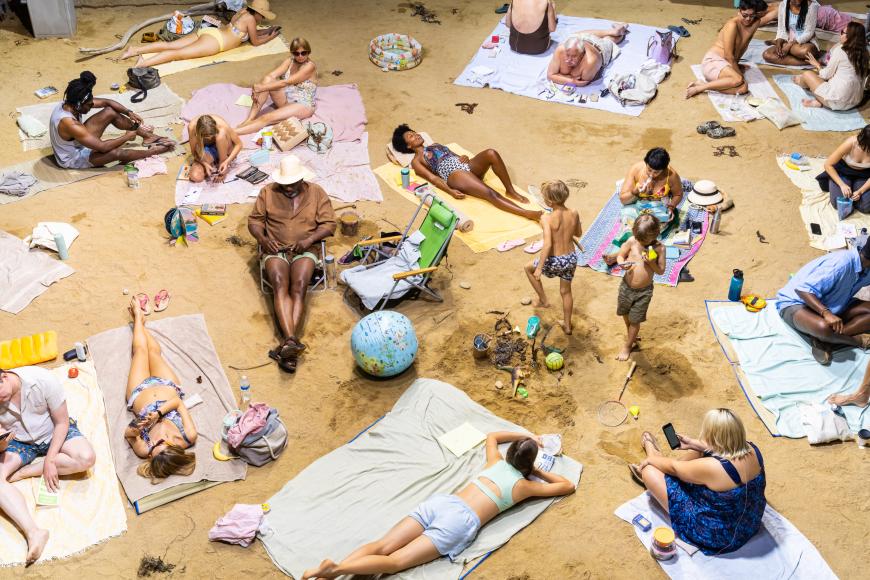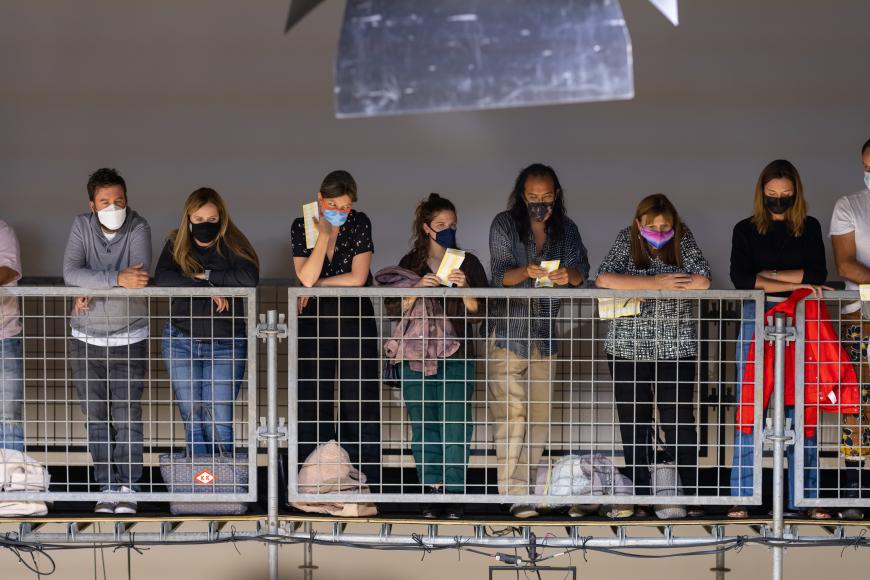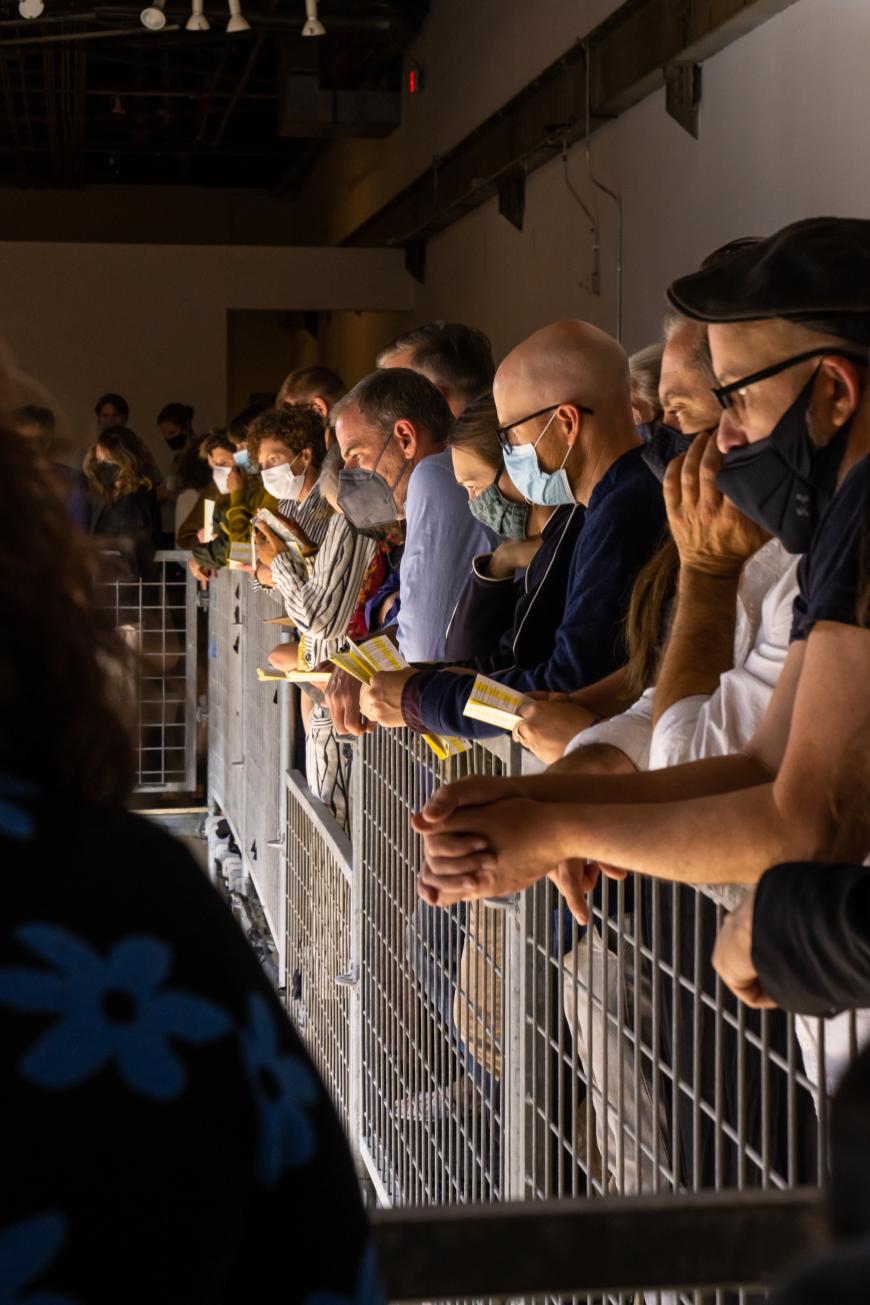
A sweet-tempered German Shepherd lazily sniffs the sand around a worn gray rubber trashcan. Nearby, a man lounges on a towel, mindlessly surfing social media on his phone amid swells of deep, warm choral harmonies. A young woman with a badminton racket launches a neon yellow shuttlecock into the air where it mingles alongside an invisible, floating melody produced by a sunbathing soprano.
Welcome to the highly anticipated, much buzzed-about, and frequently Instagrammed Los Angeles rendition of Sun & Sea, a thoughtful, enveloping work of choral and operatic performance art from Lithuanian creators Rugilė Barzdžiukaitė, Vaiva Grainytė, and Lina Lapelytė.
Following its 2019 award-winning premiere at the Venice Biennale, the indoor manmade beach of Sun & Sea landed in Germany, Greece, New York, Pennsylvania, and Arkansas. The New York Times previewed it with a splashy feature on the logistics behind the installation of all that sand, and critics in city after city have raved about its subtle beauty and prescient themes (climate change and global warming, human behavior and ennui).
In Los Angeles, the piece ran for just three days (Oct. 14–16) at The Geffen Contemporary at MOCA, not nearly enough supply to meet demand. Presented jointly by the Center for the Art of Performance at UCLA (CAP UCLA), the Hammer Museum, and MOCA, tickets for all 15 hour-long viewings of the looping work sold out within minutes.

By logging on to CAP UCLA’s website right when they went on sale last month, I managed to snag two $25 tickets to the Saturday evening 7 p.m. time slot. As I arrived at MOCA’s large downtown warehouse space, I was curious about where exactly the beach would pop-up inside the space. On a recent visit to the museum, I’d gotten lost in the disorienting maze of trippy organic urbanism that makes up Pipilotti Rist’s large and immersive retrospective, “Big Heartedness, Be My Neighbor.” Currently on view at the museum, Rist’s show takes up the bulky center of the MOCA Geffen space. When you’re inside its color-saturated, acid-tinged world, there feels like little room for anything else.
By comparison, Sun & Sea seems small and somewhat pale and bleached out, relegated to a back corner of the museum where exposed scaffolding and bright white walls frame a neat little plot of pristine sand. Perhaps the staging of Sun & Sea is meant to feel sterile, presented under cool fluorescent lighting in a space that feels like a white box. In Los Angeles, the salty Pacific is so nearby with its fragrant ocean breeze, squawking gulls, and warm sun. In proximity to the real thing, this snippet of staged beach felt a tad cold and austere. I wonder how Sun & Sea would’ve communicated if it were allowed to sprawl across more of The Geffen’s ample square footage.
Whatever its size, Sun & Sea is effective, in large part thanks to the power of the human voice and the innate pleasure of voyeurism. Looking down from the scaffolding that surrounds the crowded little beach, one gets lost in the act of staring at strangers. Normally, it would be rude to gawk at people as they lounge in their swimsuits on a beach, but here sustained gawking is encouraged. Watch as a young man slowly peels and eats a banana. Get lost in the drama of children bickering over a plastic shovel. Stare at a couple as they lounge together, hands intertwined casually. A visual feast of the ordinary that mesmerizes in its mundanity, I was surprised by how engaging all this non-activity was to observe.

Backed by minimalist electronic keyboard riffs, performers sing plaintive chants and rich harmonies. Individuals’ voices rise above the choral group, but it is hard to notice immediately who among the beach-dwellers is singing. Much of the cast is made up of Lithuanian singers touring with the work, and their comfort with the score and setting are palpable. For the most part, members of this group sing the opera’s abstract mini arias, relating slices of stories about lives affected by warming global temperatures. A wealthy woman sings about the beauty of bleached coral. A man tells a story of weather-induced travel delays. An older woman with a scratchy, worn voice sings an intoxicating ode to sunscreen as she slathers it on her husband’s freckled, wrinkled white skin.
Filling out the cast were members of the diverse L.A. ensemble Tonality. In addition to adding their voices to the choir, their presence Americanized what otherwise felt like a very European beach while also increasing the level of melanin on the sand.
The main emotion communicated during Sun & Sea is ennui. The world is burning and you’re checking Instagram. People are drowning and life’s a beach. Or, as it so happens at this moment in time, birds and fish are dying because of a massive offshore oil spill just a few miles away, and you’re inside a museum watching an art opera about climate change set on a fake beach. This opera doesn’t ask you do anything or make any changes, but rather to observe beauty and malaise, to contemplate catastrophe comfortably.

At the end of the opera, I found myself thinking about another piece of environmentally focused installation/performance art also presented by CAP UCLA in the summer of 2021. Artist Robin Frohardt’s The Plastic Bag Store features puppetry by the Puppetry Ensemble and music by Freddi Price. Like Sun & Sea, it had a limited run in downtown Los Angeles this year and was hugely popular with ticket-buyers.
That work featured a “grocery store” filled with items made entirely out of plastic bags and a narrative about plastic trash produced today that outlives generations of humans. At the end of the performance, guests are welcomed through the store’s “refrigerator” portal into an imagined futuristic museum where plastic waste is presented behind glass as precious relics from the 20th and 21st centuries. There, lit with bright white light is an exhibit featuring objects like old BIC lighters presented as “Holy Water Containers” and a plastic-foam cup on a plinth described as a “Sacred Chalice.”
Sun & Sea felt like a performance that would happen inside Frohardt’s futuristic museum for an audience living centuries from now in a world devoid of natural beaches. Imagine the rush then to snag tickets to an indoor manmade beach, the rare opportunity to experience what we, living today, often take for granted.
For now, we can still head to the beach whenever we feel like it in Los Angeles (barring the occasional wastewater or oil spill). The nature-inspired experience so many art lovers were clamoring to go see last weekend was an operatic one.
Climate change is dramatic and complex. Opera, an inherently dramatic and complex artform, is well-suited to unpack its perils and explore the lives of individuals it effects. In Sun & Sea, music washes over you like a warm breeze but rarely wows. Here, climate change is addressed aesthetically and intellectually, but less so emotionally. As our world continues to warm, it will be interesting to see what other operatic creations arise from a generation of creators facing the realities of environmental disaster like none before them.




